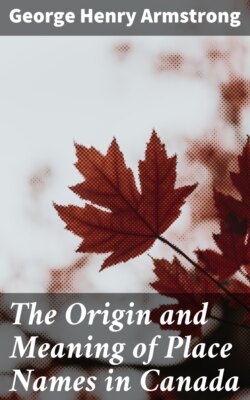Читать книгу The Origin and Meaning of Place Names in Canada - George Henry Armstrong - Страница 3
PREFACE
ОглавлениеEvery place-name is a challenge to one’s natural curiosity, a stimulus to enquiry which merits both commendation and explanation. This instinctive quality of the mind is a vital factor in its education.
A place-name is never a mere arbitrary or meaningless sound. It embodies a chapter in the story of the place to which it is attached. There is many a colourful name, rich in historic associations, on the map of Canada.
The study of place-names is, therefore, a valuable side-light on history. The direct method of seeking information in written records yields often but scanty returns or in some cases none at all. The Indian nations of Canada have left us no recorded evidence on important points, place-names and a few mounds alone afford us most of our knowledge of their life in its manifold forms.
Modern educationists make much use of place-names in arousing interest in local history—the scientific starting-point for the more extensive study of the subject—among their pupils. A thorough study of the origin of the names of places in their own township or county is made under the guidance of the teacher and the findings given to the local newspaper. Errors and omissions are pointed out by correspondents and interesting details brought to light. Thus are history and geography correlated, training of much value in investigation is afforded, and besides, a stimulus is given to patriotism.
The history of the development of place nomenclature in Canada falls into five main periods corresponding roughly with the general history of the country, revealing racial modes of thought and taste:
1. There is the Indian period which gives us so many of our melodious and strikingly appropriate names descriptive of some physical feature or commemorative of some notable event; as, Winnipeg, Niagara, Restigouche. In this connection it must never be forgotten that the Indians, like all primitive peoples, had no proper names, all of a class were described by the same word or phrase. It was the work of the white settlers to detach the Indian term from all but one locality and make it the name of a particular place in order to facilitate their business activities.
2. The period of exploration when Portuguese, Spanish and French navigators contributed expressive terms to our nomenclature; as Fundy, Bras d’or, Chaleur.
3. The French period which discloses the religious nature of the people and their appreciation of their leaders, as, St. Laurent, St. Anne, St. Marie, Louisburg, Frontenac.
4. The British Loyalist period which is marked by the deep attachment of settlers, from Great Britain and Ireland and from the United States immediately after the Revolution of 1783, to the Royal family, by their esteem for the Kingdom’s prominent statesmen, soldiers and sailors, and by their love for the place-names of the home they had left; as, Charlottetown, York, Wellington, Lincoln, London.
5. The modern or national period in which the Canadian born choose their place-names largely from the land of their birth, often in memory of the red man, oftener in commemoration of their captains of industry or statesmen and law-givers, not forgetting on occasion imperial benefactors; as, Saskatchewan, Okanagan, Fernie, Timmins, Haliburton, Kitchener.
On the whole Canada’s nomenclature is varied and attractive. It contains words from five languages and commemorates great movements and the names of many persons notable in our country’s development. The past of a country is embalmed in its place-names and literature. They are its enduring monuments.
In so great a field this volume is necessarily but a representative contribution. While a considerable part of the information has been gathered at first-hand, a still greater part has been derived from recorded sources ordinarily inaccessible, so many that it is quite impossible to give individual credit here to all. The names of many authors and correspondents are given in the text. Every other debt is hereby gratefully acknowledged.
G. H. Armstrong.
